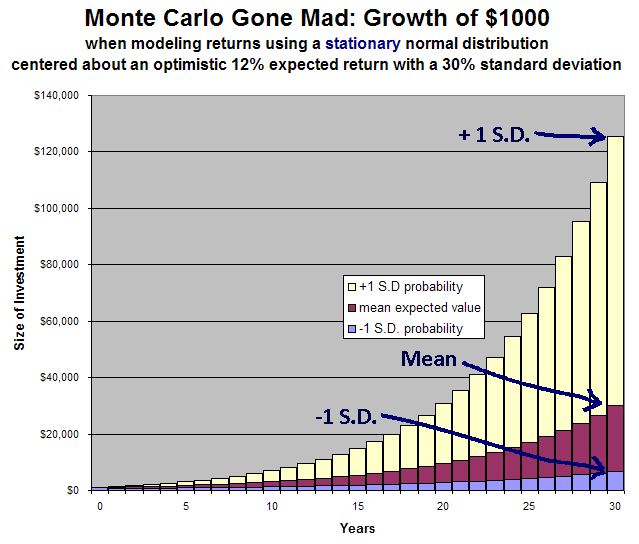Financial planning the Monte Carlo way Page 2
Post on: 16 Март, 2015 No Comment

If they set up a plan where they were going to withdraw 4 percent and they get blindsided and have to dip into their pool of assets and take out 7 percent, those are the folks who may not be on track anymore, adds Fahlund.
Not all financial planners are fans of Monte Carlo. James Shambo of Lifetime Planning Concepts in Colorado Springs, Colo. says some of the software isn’t very good.
- advertisement -
Shambo favors an approach that utilizes historical models. He has created a series of portfolios holding anywhere from no stock to 100 percent stock, in 5 percent increments. He uses bonds, real estate, and cash to make up the difference in each portfolio. Shambo factors in his client’s tolerance for risk and then runs simulations with the portfolio, testing it against specific periods in time.
I show them what would have happened to their portfolio going forward 30 years if they had retired in 1926, for instance. It’s under what circumstances do we fail, not how often do we fail.
It’s clear that the 1926-1929 years had a difficult economic environment. The client is going to say, ‘If the only time I failed was during the Great Depression, then I’m OK because I don’t think we’re going to have another depression.’ But if we see them fail in the 1950s and 1960s when there was a calm economic environment, then my client says, ‘Wow, I really need to put more cushion in there.’ Now the client can decide to work longer, save more or spend less.
Unknown variables involved
Kathie Day, a certified financial planner with Miami-based The Enrichment Group, calls Monte Carlo a useful technology, something all planners should be aware of, but agrees that there are pitfalls.
I don’t know a single client who spends exactly what they said they would when they retire. Tax laws — who can guess what taxes will be 10 years from now? And inflation — are you going to tell me what it will do?
It shows the impact of bad years early on in an investment portfolio. But if someone says, ‘Based on this there’s an 80 percent to 90 percent chance that you can retire and you’ll be fine,’ that’s all the client will hear and that’s dangerous.
Don’t leave your right to be a savvy consumer outside the door when you visit a financial planner. Ask if your portfolio will be run through Monte Carlo simulations or other math or historical models. Feel free to ask questions if you’d like an understanding of how they work. If a planner is only using Monte Carlo, it’s probably best to leave. All the planners we talked with say it’s just one piece of the puzzle and should be used in conjunction with other models.
Focus on the questions you’re being asked by the adviser, says Dan Moisand. Are they thorough? Are the objectives the same as yours? Does the adviser have you participating or are they just pumping out fancy charts and saying this is what you should do?
They shouldn’t put too much stock into the absolute number as a dictator of your behavior. They need to address the variety of returns; but we still don’t have a crystal ball. It’s the totality of what the firm does and how they communicate. If they can assure financial success because they have a better crystal ball than everyone else, you’re in a bad spot.
If you’re the do-it-yourself type, try a Monte Carlo-based calculator, but also check with your local software store or search the Web for other financial calculators that use mathematical or historical models to help you plan for retirement.
Bankrate.com has a variety of calculators for your financial needs.
— Posted: Dec. 30, 2003














